Primitive Folk Art Pictures of Children With Short Limbs
Folk Art and Crafts traditional arts and crafts evolving over time through the age-old folk practices. The distinction between what constitutes fine art and arts and crafts is frequently blurred. Thus floor and wall paintings or nakshi kantha are included in folk art while the products of potters, carpenters and weavers, as well every bit manufactures made of bamboo, cane, shola, conch-shell, ivory, bell-metal are referred to as craft. In that location are, however, some folk arts that cannot be categorised separately. For instance, an earthen pot on which fish, leaves and other designs have been painted likewise as cane mats with designs of trees, birds, mosques etc are a combination of both art and handicraft.
Folk art generally includes those articles that are traditionally made by communities of people to satisfy their religious, social and aesthetic needs. alpana or painting floors with rice paste, manasaghat, laksmir sara, mabgalghat etc are connected with social and cultural practices of the people and have no commercial value. Nonetheless, chal chitra, paintings on canvas, which have religious connotations, are likewise a ways of livelihood.
Well-nigh folk arts need very ordinary raw materials similar clay, wood, textile, thread, sola or spongewood, conch-shell, reeds, bamboo, cane and horns. Withal, some material is more expensive. Though gold jewellery does non fall into the category of folk art, ornaments fabricated of copper, brass, and silver may well be included. The implements used for making folk artifacts are very elementary. Fifty-fifty the village goldsmith, despite his use of the precious metal, also works with primitive tools, crouched on the ground over a pocket-sized flame.
Much of women's folk art has been non-commercial, whereas the folk art produced by men has a commercial value fastened to it. Thus, blacksmiths, potters, cobblers, painters, goldsmiths, brass-smiths, weavers earn their livelihood from what they produce. Traditionally, in the past, alpana artists or nakshi kantha needlewomen were working inside the home and received no monetary recompense for their labour.
Folk art uses traditional motifs reflecting the state and its people. Dissimilar forms of folk art tend to repeat these common motifs. For instance, the lotus, the dominicus, the tree-of-life, flowery creepers etc are seen in paintings, embroidery, weaving, etching and engraving. Other common motifs are fish, elephant, horse, peacock, swastika, circle, waves, temple, mosque etc. Many of these motifs take symbolical meanings. For instance, the fish represents fertility, the sheaf of paddy prosperity, the lotus purity and the swastika - commonly more than curvilinear than the Nazi symbol - good fortune.
Folk art may be divided into the post-obit categories: (i) painting: floor painting, stage scenery, painted pots, masks, wall painting, tattooing and other body painting, chal chitra, karandichitra (Manasa tales on a sola canvas), fancy pots, fancy dolls etc; (2) embroidery: nakshi kantha, nakshi pakha, handkerchiefs, etc; (3) weaving: fancy mats, nakshi shika, fancy fans, baskets, flower vases; (iv) modelling: dolls and toys, utensils, masks, moulds for making cakes and, sweets, ornaments; (5) engraving: wooden products, terracotta slabs, metal works; (vi) inlaying: ornaments inlaid with gems, pearls, diamond and other precious stones, decorating buildings and houses with coloured drinking glass and stones.
Alpana a pop folk art associated with Hindu women'southward observance of religious vratas or vows such as Laksmivrata, Senjutivrata, Maghmangalvrata, Haricharanvrata and Basudharavrata. It is as well fatigued on the occasion of Hindu weddings and annaprashana. Common motifs fatigued during weddings include the lotus and creepers. Alpana are besides drawn at Muslim weddings, especially on the occasion of the gaye halud. The alpana motifs drawn at Muslim functions are, all the same, quite different from those at vratas. On 21st Feb too alpanas using floral motifs and geometric patterns are painted on the roads leading to the shaheed minar.
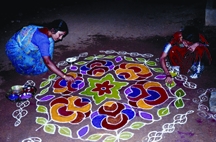
White paste fabricated of pounded rice is the main raw material for alpana. Depending on the occasion, brick powder, ash, h2o mixed with cow dung, vermilion and turmeric paste are too used. Alpanas for vratas are drawn with a finger or a piece of wood. In urban areas, alpanas are painted with enamel paints and brushes. Alpana motifs do not show realistic details. The senjutivrata alpana, representing a adult female with many children, is shown by abstract lines. Similarly, the laksmivrata alpana, representing the goddess Laksmi's human foot, is shown only as a human footprint.
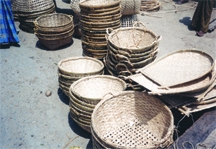
Bamboo craft Bamboo is used to make houses as well equally essential implements for farming and fishing as well every bit domestic use. Bamboo is likewise used to make musical instruments such as the ektara and the flute. Bamboo fences and partitions are often busy with floral motifs and geometric patterns. Fancy fans fabricated of bamboo depict trees, birds, elephants, flowers and conch-shaped leaves.
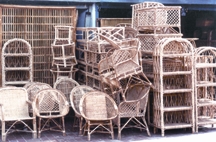
Cane arts and crafts Similar bamboo, pikestaff is likewise used to make a diverseness of household and fancy products including furniture. Chairs, stools, sofa sets, bookshelves, baskets, table lamps, partitions and hookah holders are attractive and affordable. Though less commonly used in urban areas, fancy mats called NAKSHI PATI (pictorial mat) or shitalpati (absurd mat), go along to be in demand both for their condolement and bewitchery.
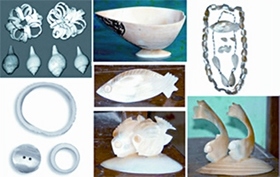
Conchshell craft Conch shells are used to make bangles, armlets, rings, lockets, buttons, hairpins and clips. Vermilion containers, incense holders, ashtrays, tabular array lamps etc are also made with shells. Despite their archaic technology, the conch-cutters of Shankhari Patti in Dhaka produce finely crafted articles.
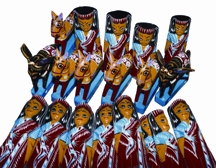
Daruchitra The fine art of wood engraving is an ancient craft, used for decorating door frames, pillars, windows, palanquins, boat prows, toys and dolls. The designs are carved out and the manifestly surfaces are then painted. Door frames and pillars are painted with creepers, palanquins with flowers, creepers and geometric patterns, and boats with the swastika, the moon, stars, birds and fish.

Dewalchitra or wall painting. Images of deities are painted on the walls of mud houses in northern Bengal in the belief that these images will protect the business firm and its inmates from evil. Flowers and leaves are painted to beautify the abode place. Autonomously from alpana designs, motifs include the swastika, the goddess Laksmi seated on a lotus, the heroes of the purana, sheaves of paddy, creepers, peacocks and elephants. Scenes from the story of krishna or Rama are painted every bit murals.
For the by two decades, wall paintings have besides get popular in Dhaka city. Many of these paintings are cleaved up into panels painted in unlike styles of folk art. The boundary wall of the Plant of Fine Arts which faces Kazi Nazrul Islam Road, for example, has scenes drawn in nakshi kantha, gazir pat, and ghatachitra styles. In addition to traditional motifs and scenes, depictions of the war of liberation are also common. During the observances of Ekushey, the walls facing the Shaheed Minar are painted with quotations in bangla script.
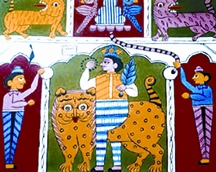
Gazir pat a grade of scroll painting, used to illustrate the life of Gazi Pir, rex of tigers. Painted in panel form, these illustrations depict various miraculous events associated with Gazi Pir. Ane such console shows Gazi seated on a tiger with its tail lifted. Gazir pat also includes other scenes and motifs, such as the goddess Ganga riding the makara a mythological aquatic creature, a cow beingness grabbed by a tiger, and Daksin Ray, also regarded as a king of tigers, holding a mallet in his hand. There are withal ane or two patuyas in Munshiganj and Narsingdi who pigment Gazir pat.
Ghatachitra Paintings on earthen pitchers or ghat. There are various types of ghatachitra such as mabgalghat, manasaghat, nagaghat, laksmighat, kartiker bhand and daksinrayer bara, the names being derived from the deity painted on the pitcher. Thus, manasaghats depict manasa, the ophidian goddess, while nagaghats depict hooded snakes.
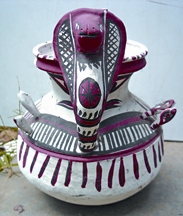
A pitcher with the image of an viii-headed snake is called 'astanaga ghat'. Similarly, a pitcher depicting Laksmi, the goddess of wealth, is called 'laksmir ghat', while a ghat with the paradigm of Daksin Ray, the tiger god, is known every bit 'daksin rayer bara'. The manasaghat is the nigh ornate and popular of this folk genre.
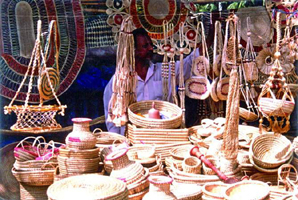
Jute craft Apart from being the raw cloth for hessian and carpets, jute is besides used to make mats, numberless, and hanging cord bags or sika, used in homes to hang foodstuff out of the reach of animals. To make sikas, jute twine is braided and so tied in diverse patterns such as taraful, puntiful and takaful. The sikas are given different names such equally muthashika, chakshika, kadishika and nengtashika on the basis of their size, shape and designs. Kadisika, for case, is threaded with cowries.
Karandichitra panel paintings on sola, depicting the goddess Manasa. These paintings are made on the occasion of Manasa puja. First a karandi, a square frame resembling a temple, is fabricated with sola and paper. And then boxes are fatigued at the top and the bottom portraying manasa, behula, Laksindar, Chand Sadagar, Behula's vii brothers and their wives, a sage, fishermen, snake charmers, washermen, trumpeters and coiled snakes. At the end of the puja, the karandi is fix afloat on h2o.
Metalcraft Gold and silver ornaments and plates, glasses, pitchers and mugs made of silver and bell metal have been in use since ancient times. Flower vases, ashtrays, tabular array lamps, containers for cosmetics, and various decoration pieces are besides beingness made. Diverse motifs such as flowers, creepers, birds and geometric patterns are engraved on pitchers, glasses and mugs.
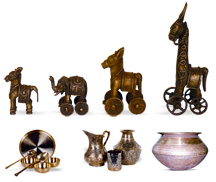
Gold and argent ornaments, to adorn women from caput to foot, are made in innumerable designs. Traditional ornaments include the makaramukhi mal (the makara-faced anklet), an anklet designed in the shape of the makara. Lockets are designed like flowers, collywobbles and geometric patterns. Ornaments are also gear up with precious cutting stones, gems and pearls.
Nakshi kantha or embroidered quilt is fabricated and used near everywhere in People's republic of bangladesh. However, the nakshi kanthas of Rajshahi, Jessore, and Faridpur are most famous for stitchcraft and picturesque designs. Several layers of old fabric are put together to make these quilts. Apart from being used to make bedspreads and quilts, nakshi kantha work is also used to make pillow cases and covers, prayer mats, seats for puja, modest bags for keeping mirrors and combs, gilaf (covers) for books, covers for foods, and dastarkhan or dining mats.
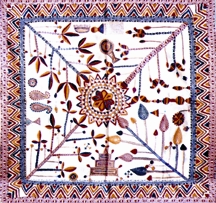
The designs were traditionally drawn free paw by women who worked leisurely in their spare time. At present much nakshi kantha work is done by ngos and handicraft organisations for commercial purposes. Common motifs are the lotus, the sun, the moon, stars, leaves, trees, flowering creepers, human figures, deities, horses, elephants, fish, birds, tazias and rath. Elaborately embroidered quilts depict scenes from mythology or gimmicky life. Traditionally, threads drawn from sari borders were used. At present embroidery thread is used or skeins of yarn.
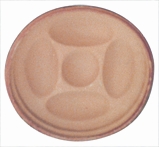
Nakshi moulds Decorative moulds or blocks of varied designs are fabricated with clay, stone or forest. Wooden blocks are employed to print fabrics using different colours. Moulds of wood, clay and rock are used to make decorative cakes and sweets. Stone moulds are engraved with creepers, flowers and fruits. Wooden moulds are made by carpenters, only clay moulds are made by village women themselves
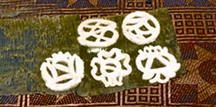
Nakshi pitha or decorative cakes are made by shaping dough of pounded rice into various designs. These are then fried in oil and soaked in sugar syrup. Traditional motifs for nakshi pitha are geometric patterns, wheels, betel leafage, flowers in bloom, fish, birds etc. Nakshi pithas are more than popular in Dhaka and Mymensingh and are peculiarly made to entertain guests at weddings.
Ornamental woodwork A variety of motifs and designs are carved on doors, windows, pillars, joists, rafters, chests, beds, divans, depression seats, cake moulds, cases of musical instruments, palanquins, chariots, boats and dolls. Common motifs include the lotus, birds, flowery creepers, circles and geometric designs.
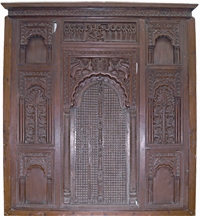
Ornamental wooden door and window
The lotus is engraved on doors, beds, chests and low seats; flowery creepers and geometric patterns on door frames, pillars, bed posts and palanquins; peacocks and parrots on cases of musical instruments; and lotuses and peacocks on boats. The bangladesh national museum in Dhaka has in its collection an exquisitely carved wooden statue of a woman named 'sursundari'.
Painted masks In many folk festivals, artistes would wear painted masks. In religious dances the performers would wear masks depicting the faces of the deities. shiva'due south face, for instance, would be fabricated by dabbing mud on a piece of cloth fixed around a wooden frame. Kali's face was painted blue, her eyes white and black and her natural language red.
Patachitra or scroll paintings by professional artists, known as patuyas, are used to illustrate different narratives. These roll paintings date dorsum to the Buddhist period when Buddhist bhikkus known as 'maskari' used to spread the message of buddhism by showing pictures to illustrate stories of the Buddha. Later on, during Hindu rule, these scroll paintings depicted stories from the Puranas.
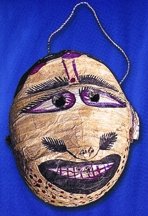
Many Hindus were converted to Islam afterwards the Muslim conquest of Bengal in the 13th century. They did non carelessness the merchandise they had learned, but added Muslim stories to their repertoire. Thus, they continued to paint stories of Krishnalila, Ramalila, and Manasalila, stories of Krishna, Rama and Manasa, and at the aforementioned time painted scrolls depicting the deeds of Gazi Pir and Bibi Sonabhan and the tragic events at Karbala.
The illustrations were first painted on silk cloth or linen and afterward on paper fabricated of cotton-pulp. There are two kinds of patachitra in Bangladesh: unmarried pictures on a square sheet and multiple pictures on a long curlicue. kalighat paintings belong to the start category. This way of painting developed during the 18th-19th centuries after the institution of Kolkata. The Kalighat schoolhouse disappeared after western style painting became pop.
The traditional patachitra illustrates different episodes of a story on a roll up to 30 feet long. As the scrolls are wrapped around sticks, these are besides known as 'wrapped pictures'. There is some other kind of scroll known equally 'pavchakalyani pat' which contains illustrations of different deities.
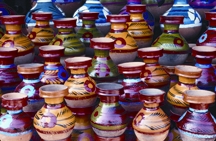
Pottery Inexpensive household utensils are made of clay as are images of Hindu gods and goddesses for pujas and devotional rites. Dolls, toys, and decoration pieces are also made in most parts of Bangladesh. Some clay products are decorated with designs of leaves, flowers, birds etc while others are left apparently.
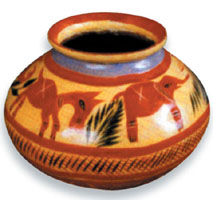
Sakher handi or dirt pots painted with motifs of fish, birds, lotus, leaves and geometric designs in bold castor strokes. Common colours are blood-red, yellow and green. Both motifs and colours are symbolic of fertility, which is why these pots are used to carry gifts of fruit and sweets at weddings. Rajshahi is well known for these pots.
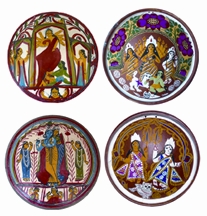
Sarachitra this big dirt plate painted with the image of the goddess Laksmi is also known equally 'Laksmir sara' or Laksmi's pat. The plate is first painted white and then the image of the deity, frequently shown seated on an owl, is painted in yellowish, cherry, and black. On some lids, she is shown with Durga, her female parent, and Saraswati, her sister. On other plates she is shown in a panel with the images of radha and krishna.
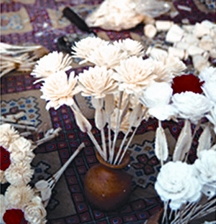
Sola craft Sola or spongewood, obtained from a plant that grows in paddy fields and shallow h2o-bodies, is used to make a variety of decorative manufactures. Traditional articles include backdrops for images of deities and topar, or headgear, for brides and bridegrooms. Topars are usually decorated with kadam flowers. Other items include dolls, birds, elephants, flowers, boats, garlands etc.
Vaishnavas install sola images of Radha and Krishna on platforms at rasa festivals and worship them. Mabgalik, garlands of kadam flowers, are hung in houses in the belief that they bring practiced luck. Sola hats were popular during British dominion. A sharp knife and a pair of scissors are the chief implements for this arts and crafts.
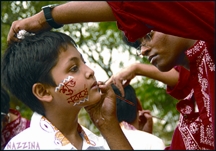
Ulki or tattooing is a form of body art using permanent pigments. Men and women of some Hindu castes tattoo parts of their trunk for religious reasons, usually with motifs of the sunday, birds, snakes or circles. Vaishnavas tattoo pictures of Radha and Krishna united in an embrace. Tattooing is done by pricking the skin of the arms with a needle and and then applying the juice of kesutia (Eclipta prostata) leaves to obtain a bluish color. At that place are other forms of body painting that are temporary. Bengali brides, both Hindu and Muslim, accept their faces dotted with sandalwood paste. Muslim brides utilise mehendi or henna to paint their palms with intricate designs.
Both the housewife painting alpana or stitching a kantha and the traditional craftsman working in metal or woods have contributed to the rich folk fine art of Bengal. Drawing upon traditional motifs as well every bit upon the earth around them, they produce vibrant pieces of fine art by using unproblematic raw materials and humble implements. Whether fulfilling an artful demand, performing a religious duty or pursuing a livelihood, these paid and unpaid folk artists have made Bangladesh a vast storehouse of colourful and varied folk arts. [Wakil Ahmed]
Bibliography Tofail Ahmad, Loka-Aitihyer Dash Diganta, Dhaka, 1999; Ajit Mookherjee, Folk Toys of Republic of india, Calcutta, 1956; Abanindranath Tagore, Banglar Vrata, Calcutta, 1947; Dinesh Chandra Sen, Brihat Vanga, 1st Office, Calcutta, 1934.
See too bamboo craft; cane; conch crafts; nakshi shika; pottery; ulki; woodworks.
Source: https://en.banglapedia.org/index.php/Folk_Art_and_Crafts
0 Response to "Primitive Folk Art Pictures of Children With Short Limbs"
Post a Comment